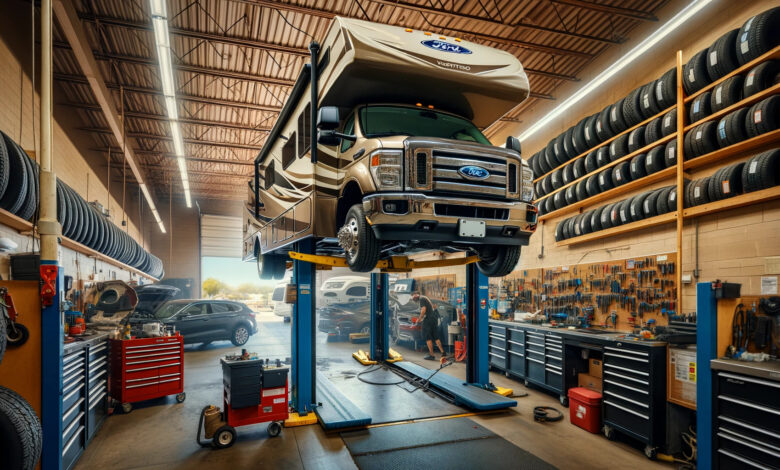Enhance Your RV Repair Business with Top Roof Maintenance Solutions

A well-maintained roof means more enjoyable trips. But when problems arise, they can turn a dream journey into a nightmare. Keeping an RV roof in top shape is crucial for a smooth and trouble-free customer experience. Let’s look into the common issues RV owners face with their roofs. And how your RV repair business can offer practical solutions to keep them cruising confidently.
How can your RV Repair Business Provide Solutions?
Roof Leaks
Roof leaks usually happen because of:
- Damaged Seams
- Loose Fittings
- Punctures
Joints where different parts of the roof meet can become worn or cracked over time. Fittings, like vents or skylights, might loosen, letting water seep in. Punctures from debris or accidents can also create openings for water to get through.
Symptoms
Look for signs of a leak. Inside the RV, look for water stains on the ceiling or walls. Damp spots and mold growth are red flags that water is getting in.
Solutions
Inspection
Start by carefully examining the roof. Look for any visible damage, like cracks or holes. Check around seams, vents, and other fittings. Sometimes, you might need to get on the roof or use a ladder for a good view. If you need help determining where the leak comes from, try a water test: spray the roof using a hose and watch for leaks inside.
Repair
If you find a leak, you can often fix it with RV roof sealant. Clean the area around the leak thoroughly before applying the sealant. You should use a patching method for larger holes or more significant damage. Apply a patch and seal around the edges. If the damage is extensive, replacing roof sections might be necessary.
Cracked or Damaged Roof Membrane
The roof membrane of an RV is its primary layer of protection against the elements. However, it can suffer from cracks or damage over time. This often happens due to prolonged UV exposure from the sun and harsh weather conditions like:
- Heavy Rain
- Hail
- Impacts from Debris
When the membrane is compromised, it can no longer effectively shield RV from water and other environmental hazards.
Symptoms
Look for visible signs of damage. Cracks, tears, or bubbles on the roof indicate that the membrane may be compromised. These issues can let water seep in, leading to more significant RV problems.
Solutions
Inspection
Start by carefully examining the roof membrane for any visible damage. Look for cracks, tears, or bubbles. Assess the severity of the damage—small cracks might be manageable with a simple repair, while large tears or extensive damage could require more significant work.
Repair
Roof patch kits can be a quick fix for minor damage. Clean the damaged area thoroughly before applying the patch. Professional membrane replacement might be necessary for more severe damage or extensively compromised membranes. This involves removing the damaged sections and installing new membrane material to ensure a proper seal and protection.
Roof Ventilation Issues
Proper ventilation is crucial for maintaining a comfortable and healthy environment inside an RV. Roof vents help:
- Manage Airflow
- Reduce Moisture
- Prevent Unpleasant Odors
However, vents can experience problems such as being broken or leaking. These issues can affect an RV’s overall ventilation and comfort, leading to more significant problems if not addressed.
Symptoms
Watch for signs that roof vents might be having trouble. Unpleasant odors inside the RV could indicate poor ventilation or leaks. Inadequate airflow can make the interior stuffy and uncomfortable. Visible damage to the vents, such as cracks or broken parts, is another clear sign that something might be wrong.
Solutions
Inspection
Begin by thoroughly inspecting the roof vents. Look for any cracks in the vent covers, loose or missing covers, or improper seals around the vents. Pay attention to any signs of wear or damage that could affect their functionality.
Repair
If you find any problems, you can often fix them with simple steps. For minor leaks or damaged seals, resealing the area with RV roof sealant can help restore proper function. Replacing a vent cover might be necessary if it is cracked or broken. Vent covers are typically available at RV supply stores or online, and replacing them usually involves removing the old cover and securing a new one in place.
Accumulated Debris and Dirt
Over time, RV roofs can accumulate leaves, dirt, and other debris. While it might seem minor, this debris can cause significant problems. Leaves and dirt can:
- Block Drainage Systems
- Cause Water Pooling
- Result in Potential Leaks
Mold and mildew can start growing in damp, cluttered areas, and debris can contribute to roof deterioration.
Symptoms
Watch for signs that debris might be causing issues on the RV roof. Clogged drainage can result in water pooling on the roof, eventually leading to leaks. Mold growth, which might appear as dark spots or stains, indicates that moisture is trapped and not evaporating correctly. Roof deterioration can manifest as visible damage or wear, particularly in areas with accumulated debris.
Solutions
Cleaning
Regular cleaning is essential to keeping RV roofs in good shape. Use a soft-bristle brush or a broom to sweep off leaves, dirt, and other debris gently. A mild detergent mixed with water can scrub the roof for more thorough cleaning. Be careful not to use harsh chemicals or abrasive tools that could damage the roof’s surface.
Debris Removal
Use a ladder and appropriate safety gear to remove debris from the RV roof safely. Avoid stepping directly on delicate areas of the roof. While you’re up there, check for any signs of damage or wear. If you notice cracks or loose seals, address them promptly to prevent further problems.
Roof Ponding
Roof ponding occurs when water accumulates and pools on the RV roof instead of draining away. Over time, this standing water can lead to various structural issues. Prolonged ponding can:
- Leaken the Roof Material
- Lead to Leaks
- Cause Mold Growth
In severe cases, it can contribute to structural damage and compromise the integrity of the RV’s roof.
Symptoms
The most obvious sign of roof ponding is standing water on the roof after a rainstorm. If you notice water pooling in certain areas and not draining away, it indicates an issue with the roof’s slope or drainage system.
Solutions
Inspection
To address roof ponding:
- Inspect the RV roof for areas where water collects.
- Look for low spots or uneven areas where water tends to pool.
- Check if the roof surface is sagging or if any obstructions are blocking proper drainage.
Repair
You may need to adjust the roof if you identify areas where water collects. This could involve modifying the roof pitch to create a more effective slope for drainage. Adding drainage solutions, such as additional roof drains or enhancing existing drainage channels, might also be necessary.
Structural Damage
Structural damage to RV roofs can occur due to accidents, heavy impacts, or severe weather conditions. Such damage can compromise the roof’s integrity, leading to more significant problems if not addressed. Impacts from falling debris, hail, or even accidental collisions can cause:
- Dents
- Bends
- Sagging in the Roof Structure
- Affecting Appearance and Functionality
Symptoms
Look out for visible signs of structural damage. Dents or bends in the roof surface indicate that it has sustained a significant impact. Sagging sections are also a red flag, suggesting that the roof may weaken or have underlying damage.
Solutions
Inspection
Start by thoroughly inspecting the roof for signs of structural damage. Check for dents, bends, or any sections that appear to be sagging. Assess the extent of the damage—minor dents may require simple reinforcement, while more severe issues might need significant repairs or replacements. Pay special attention to areas around roof supports and structural joints, as these are crucial for overall stability.
Repair
Reinforcing the affected areas with additional support or repair materials can often be sufficient for minor damage. To address more minor issues, use appropriate materials designed for RV roofs, such as metal braces or sealants. For more severe damage, you may need to replace damaged roof sections. This might involve removing and replacing affected panels or structural supports.
Conclusion
Taking care of an RV roof is like giving a vehicle a reliable shield against the elements. From fixing leaks and repairing a cracked membrane to managing ventilation issues and preventing ponding, each step helps protect the RV’s roof from potential damage. A well-maintained roof extends an RV’s life and enhances the customer’s travel experience. Ultimately, this has a positive effect on your RV repair business.
Also Read: Detailed Project Report on Feminine Hygiene Wipes Manufacturing Plant Setup By IMARC Group




